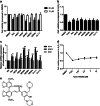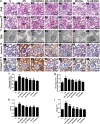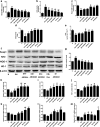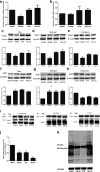A novel compound AB38b attenuates oxidative stress and ECM protein accumulation in kidneys of diabetic mice through modulation of Keap1/Nrf2 signaling
- PMID: 31645661
- PMCID: PMC7470857
- DOI: 10.1038/s41401-019-0297-6
A novel compound AB38b attenuates oxidative stress and ECM protein accumulation in kidneys of diabetic mice through modulation of Keap1/Nrf2 signaling
Abstract
Extracellular matrix (ECM) deposition following reactive oxygen species (ROS) overproduction has a key role in diabetic nephropathy (DN), thus, antioxidant therapy is considered as a promising strategy for treating DN. Here, we investigated the therapeutic effects of AB38b, a novel synthetic α, β-unsaturated ketone compound, on the oxidative stress (OS) and ECM accumulation in type 2 diabetes mice, and tried to clarify the mechanisms underlying the effects in high glucose (HG, 30 mM)-treated mouse glomerular mesangial cells (GMCs). Type 2 diabetes model was established in mice with high-fat diet feeding combined with streptozocin intraperitoneal administration. The diabetic mice were then treated with AB38b (10, 20, 40 mg· kg-1· d-1, ig) or a positive control drug resveratrol (40 mg· kg-1· d-1, ig) for 8 weeks. We showed that administration of AB38b or resveratrol prevented the increases in malondialdehyde level, lactate dehydrogenase release, and laminin and type IV collagen deposition in the diabetic kidney. Simultaneously, AB38b or resveratrol markedly lowered the level of Keap1, accompanied by evident activation of Nrf2 signaling in the diabetic kidney. The underlying mechanisms of antioxidant effect of AB38b were explored in HG-treated mouse GMCs. AB38b (2.5-10 μM) or resveratrol (10 μM) significantly alleviated OS and ECM accumulation in HG-treated GMCs. Furthermore, AB38b or resveratrol treatment effectively activated Nrf2 signaling by inhibiting Keap1 expression without affecting the interaction between Keap1 and Nrf2. Besides, AB38b treatment effectively suppressed the ubiquitination of Nrf2. Taken together, this study demonstrates that AB38b ameliorates experimental DN through antioxidation and modulation of Keap1/Nrf2 signaling pathway.
Keywords: AB38b; ECM; Keap1; Nrf2; antioxidant; diabetic nephropathy; glomerular mesangial cells; oxidative stress; resveratrol.
Conflict of interest statement
The authors declare no competing interests.
Figures









References
-
- Du Yan, Xu Bing-ju, Deng Xu, Wu Xiao-wen, Li Yin-jie, Wang Shi-rui, Wang Yi-nan, Ji Shuai, Guo Meng-zhe, Yang Dong-zhi, Tang Dao-quan. Predictive metabolic signatures for the occurrence and development of diabetic nephropathy and the intervention of Ginkgo biloba leaves extract based on gas or liquid chromatography with mass spectrometry. Journal of Pharmaceutical and Biomedical Analysis. 2019;166:30–39. - PubMed
-
- Han Q, Zhu H, Chen X, Liu Z. Non-genetic mechanisms of diabetic nephropathy. Front Med. 2017;11:319–32. - PubMed
-
- Sun Z, Ma Y, Chen F, Wang S, Chen B, Shi J. Artesunate ameliorates high glucose-induced rat glomerular mesangial cell injury by suppressing the TLR4/NF-kappaB/NLRP3 inflammasome pathway. Chem Biol Interact. 2018;293:11–9. - PubMed
MeSH terms
Substances
LinkOut - more resources
Full Text Sources
Medical

